check engine Citroen C3 2015 2.G Owner's Manual
[x] Cancel search | Manufacturer: CITROEN, Model Year: 2015, Model line: C3, Model: Citroen C3 2015 2.GPages: 401, PDF Size: 13.04 MB
Page 5 of 401
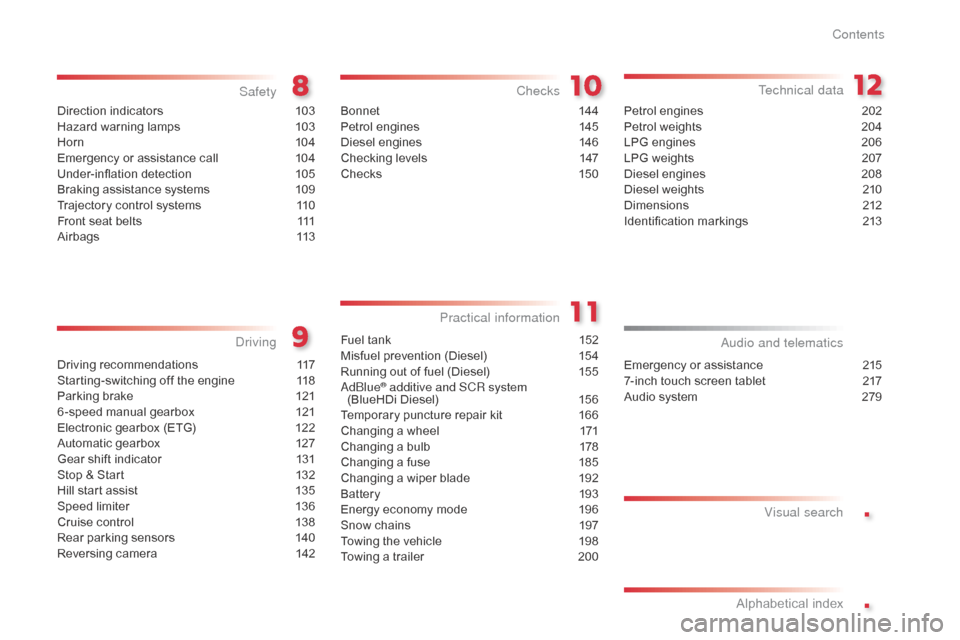
.
.
Direction indicators 103
Hazard warning lamps 1 03
Horn
10
4
Emergency or assistance call
1
04
Under-inflation detection
1
05
Braking assistance systems
1
09
Trajectory control systems
1
10
Front seat belts
1
11
Airbags
1
13
Safety
Driving recommendations 1 17
Starting-switching off the engine 1 18
Parking brake
1
21
6 -speed manual gearbox
1
21
Electronic gearbox (ETG)
1
22
Automatic gearbox
1
27
Gear shift indicator
1
31
Stop & Start
1
32
Hill start assist
1
35
Speed limiter
1
36
Cruise control
1
38
Rear parking sensors
1
40
Reversing camera
1
42
driving
Emergency or assistance 2 15
7-inch touch screen tablet 2 17
Audio system
2
79
audio and telematics
Alphabetical index
Bonnet 14 4
Petrol engines 1 45
Diesel engines
1
46
Checking levels
1
47
Checks
15
0
Checks
Fuel tank 152
Misfuel prevention (Diesel) 1 54
Running out of fuel (Diesel)
1
55
a
d
blu
e
® additive and SCR system
(BlueHDi Diesel) 1 56
Temporary puncture repair kit
1
66
Changing a wheel
1
71
Changing a bulb
1
78
Changing a fuse
1
85
Changing a wiper blade
1
92
Battery
1
93
Energy economy mode
1
96
Snow chains
1
97
Towing the vehicle
1
98
Towing a trailer
2
00
Practical information Technical data
Petrol engines 2
02
Petrol weights 2 04
LPG engines
2
06
LPG weights
2
07
Diesel engines
2
08
Diesel weights
2
10
Dimensions
2
12
Identification markings
2
13
Visual search
C3_en_Chap00a_sommaire_ed01-2015
Contents
Page 11 of 401
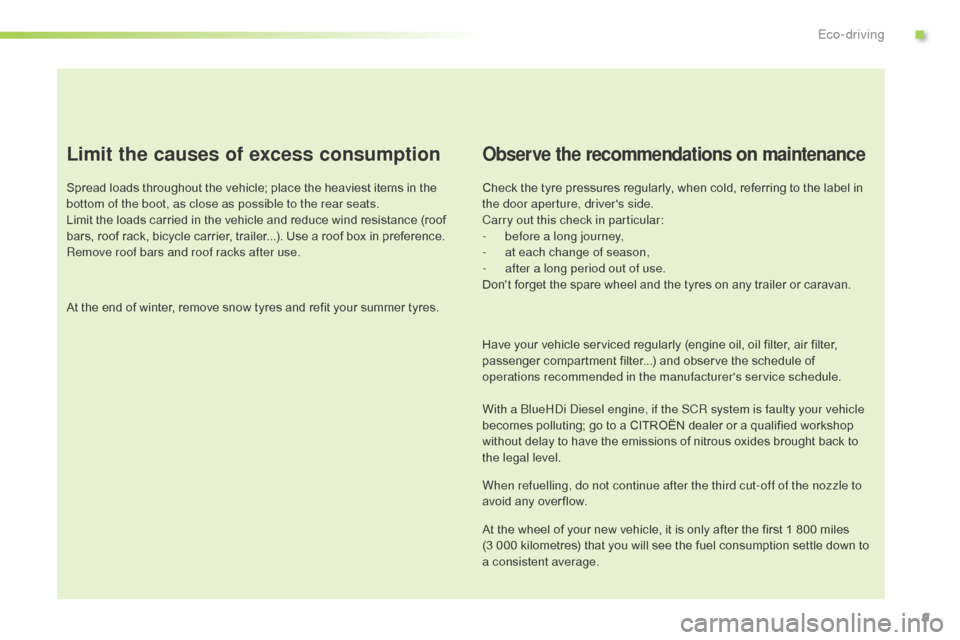
9
Limit the causes of excess consumption
Spread loads throughout the vehicle; place the heaviest items in the
bottom of the boot, as close as possible to the rear seats.
Limit the loads carried in the vehicle and reduce wind resistance (roof
bars, roof rack, bicycle carrier, trailer...). Use a roof box in preference.
Remove roof bars and roof racks after use.
At the end of winter, remove snow tyres and refit your summer tyres.
Observe the recommendations on maintenance
Check the tyre pressures regularly, when cold, referring to the label in
the door aperture, driver's side.
Carry out this check in particular:
-
b
efore a long journey,
-
a
t each change of season,
-
a
fter a long period out of use.
Don't forget the spare wheel and the tyres on any trailer or caravan.
Have your vehicle serviced regularly (engine oil, oil filter, air filter,
passenger compartment filter...) and observe the schedule of
operations recommended in the manufacturer's service schedule.
With a
b
l
ueH
di
d
i
esel engine, if the SCR system is faulty your vehicle
becomes polluting; go to a CITROËN dealer or a qualified workshop
without delay to have the emissions of nitrous oxides brought back to
the legal level.
When refuelling, do not continue after the third cut-off of the nozzle to
avoid any over flow.
At the wheel of your new vehicle, it is only after the first 1 800 miles
(3
000 kilometres) that you will see the fuel consumption settle down to
a consistent average.
.
Eco-driving
Page 20 of 401
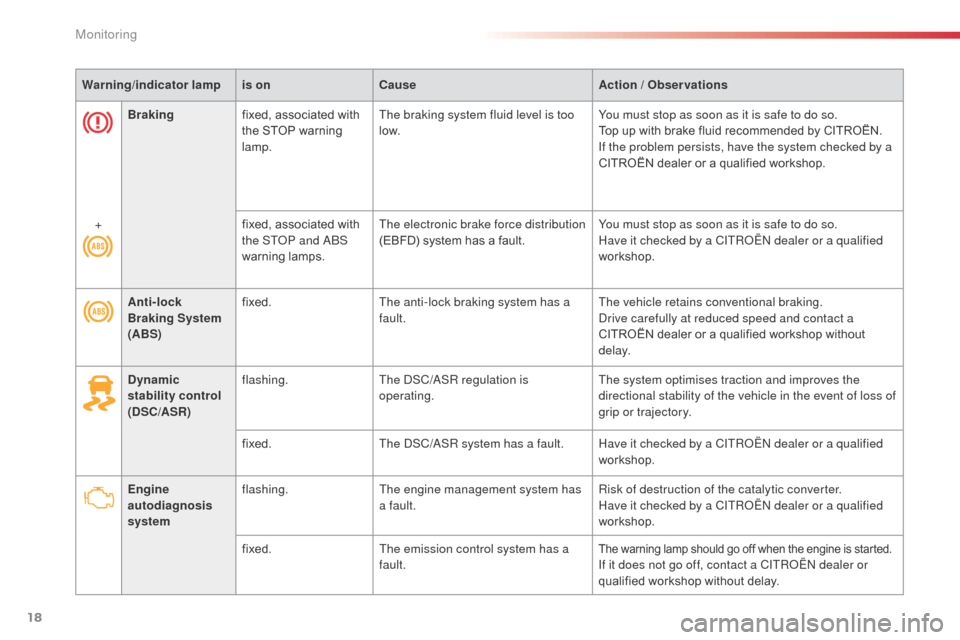
18
Warning/indicator lampis on Cause Action / Observations
Anti-lock
Braking System
(ABS) fixed.
The anti-lock braking system has a
fault. The vehicle retains conventional braking.
dr
ive carefully at reduced speed and contact a
CITROËN dealer or a qualified workshop without
d e l ay.
Dynamic
stability control
(DSC/ASR) flashing.
The
d
S
C/
aS
R regulation is
operating. The system optimises traction and improves the
directional stability of the vehicle in the event of loss of
grip or trajectory.
fixed. The
d
S
C/
aS
R system has a fault. Have it checked by a CITR
oËn
dealer or a qualified
workshop.
Engine
autodiagnosis
system flashing.
The engine management system has
a fault. Risk of destruction of the catalytic converter.
Have it checked by a CITR
oËn
dealer or a qualified
workshop.
fixed. The emission control system has a
fault.
The warning lamp should go off when the engine is started.If it does not go off, contact a CITRoËn dealer or
qualified workshop without delay.
Braking
fixed, associated with
the STOP warning
lamp. The braking system fluid level is too
low.
You must stop as soon as it is safe to do so.
Top up with brake fluid recommended by CITROËN.
If the problem persists, have the system checked by a
CITROËN dealer or a qualified workshop.
+ fixed, associated with
the ST
oP a
nd
ab
S
w
arning lamps.
The electronic brake force distribution
(EBFD) system has a fault.
You must stop as soon as it is safe to do so.
Have it checked by a CITR
oËn
dealer or a qualified
workshop.
Monitoring
Page 22 of 401

20
Airbagstemporarily. This lamp comes on for a few
seconds when you turn on the
ignition, then goes off. This lamp should go off when the engine is started.
If it does not go off, contact a CITRoËn
dealer or a
qualified workshop.
fixed.
on
e of the airbag or seat belt
pretensioner systems has a fault. Have it checked by a CITR
oËn
dealer or a qualified
workshop.
Seat belt not
fastened /
unfastened fixed then flashing
accompanied by an
increasing audible
signal. The driver and/or the front passenger
has not fastened or has unfastened
their seat belt.
Pull the strap then insert the tongue in the buckle.
Warning
/indicator lampis on Cause Action / Observations
Door(s) open fixed if the speed is
below 6 mph (10 km/h).
a
door or the boot is still open. Close the door or boot.
fixed and accompanied
by an audible signal
if the speed is above
6 mph (10 km/h).
Power steering fixed. The power steering has a fault.
dr
ive carefully at reduced speed.
Have it checked by a CITR
oËn
dealer or a qualified
workshop.
Monitoring
Page 23 of 401
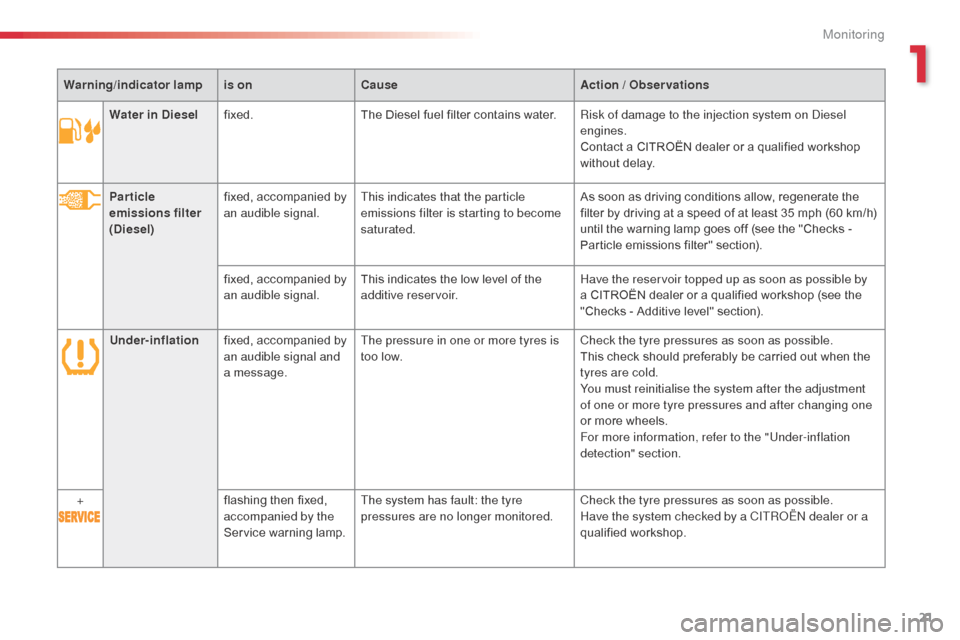
21
Warning/indicator lampis on Cause Action / Observations
Water in Diesel fixed. The Diesel fuel filter contains water. Risk of damage to the injection system on
d
i
esel
engines.
Contact a CITROËN dealer or a qualified workshop
without delay.
Particle
emissions filter
(Diesel) fixed, accompanied by
an audible signal.
This indicates that the particle
emissions filter is starting to become
saturated. As soon as driving conditions allow, regenerate the
filter by driving at a speed of at least 35 mph (60 km/h)
until the warning lamp goes off (see the "Checks
-
Particle emissions filter" section).
fixed, accompanied by
an audible signal. This indicates the low level of the
additive reservoir. Have the reservoir topped up as soon as possible by
a CITROËN dealer or a qualified workshop (see the
"Checks - Additive level" section).
Under-inflation fixed, accompanied by
an audible signal and
a message. The pressure in one or more tyres is
too low.
Check the tyre pressures as soon as possible.
This check should preferably be carried out when the
tyres are cold.
You must reinitialise the system after the adjustment
of one or more tyre pressures and after changing one
or more wheels.
For more information, refer to the "Under-inflation
detection" section.
+ flashing then fixed,
accompanied by the
Service warning lamp.The system has fault: the tyre
pressures are no longer monitored.
Check the tyre pressures as soon as possible.
Have the system checked by a CITR
oËn
dealer or a
qualified workshop.
1
Monitoring
Page 29 of 401
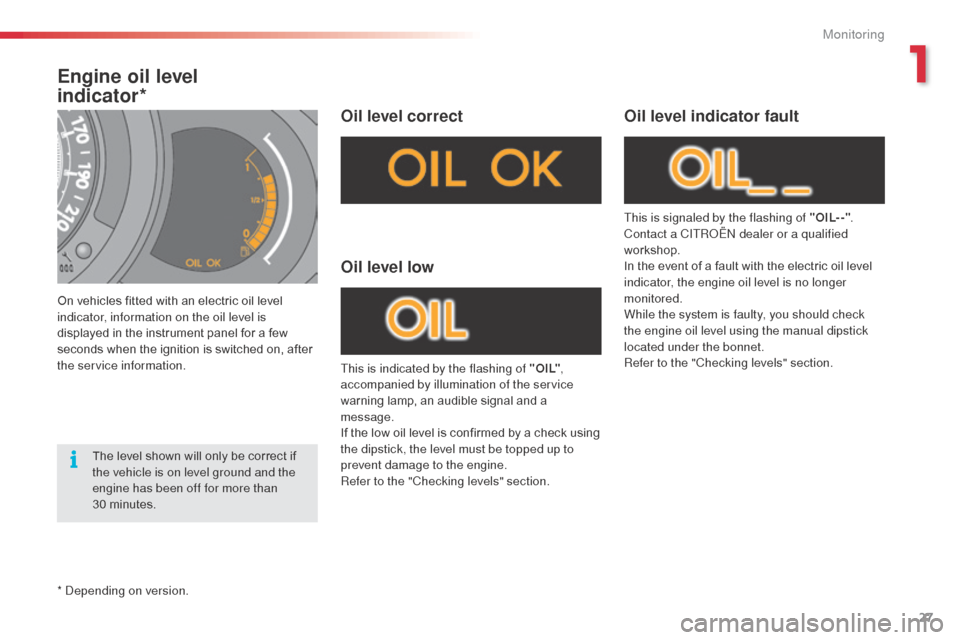
27
Engine oil level
indicator*
On vehicles fitted with an electric oil level
indicator, information on the oil level is
displayed in the instrument panel for a few
seconds when the ignition is switched on, after
the service information.
Oil level correct
This is indicated by the flashing of " O I L",
accompanied by illumination of the service
warning lamp, an audible signal and a
message.
If the low oil level is confirmed by a check using
the dipstick, the level must be topped up to
prevent damage to the engine.
Refer to the "Checking levels" section.
Oil level low
This is signaled by the flashing of "OIL- -" .
Contact a CITRoËn dealer or a qualified
workshop.
In the event of a fault with the electric oil level
indicator, the engine oil level is no longer
monitored.
While the system is faulty, you should check
the engine oil level using the manual dipstick
located under the bonnet.
Refer to the "Checking levels" section.
Oil level indicator fault
The level shown will only be correct if
the vehicle is on level ground and the
engine has been off for more than
30 minutes.
*
d
ep
ending on version.
1
Monitoring
Page 48 of 401
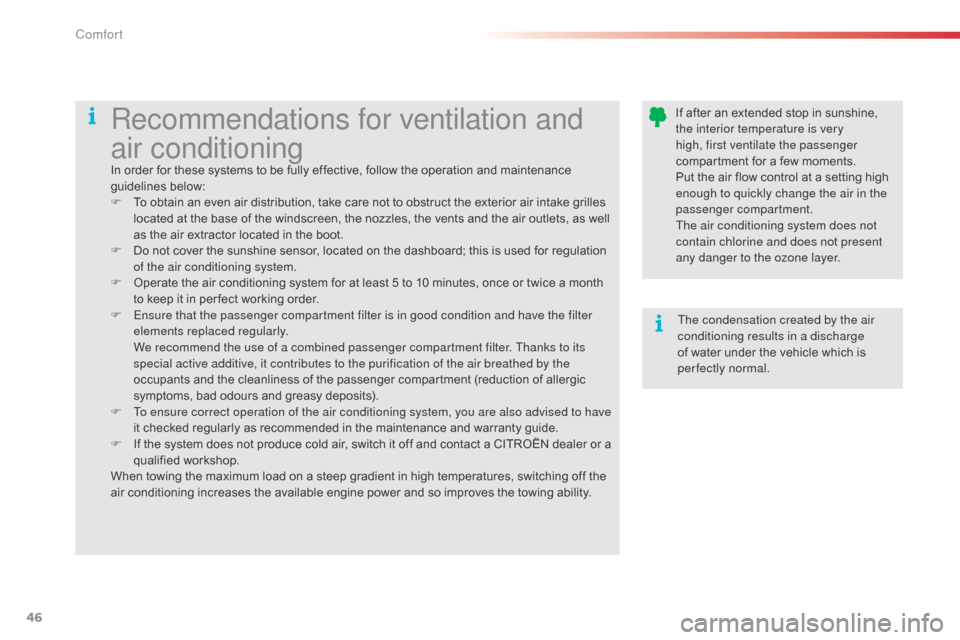
46
If after an extended stop in sunshine,
the interior temperature is very
high, first ventilate the passenger
compartment for a few moments.
Put the air flow control at a setting high
enough to quickly change the air in the
passenger compartment.
The air conditioning system does not
contain chlorine and does not present
any danger to the ozone layer.The condensation created by the air
conditioning results in a discharge
of water under the vehicle which is
perfectly normal.Recommendations for ventilation and
air conditioning
In order for these systems to be fully effective, follow the operation and maintenance
guidelines below:
F
T
o obtain an even air distribution, take care not to obstruct the exterior air intake grilles
located at the base of the windscreen, the nozzles, the vents and the air outlets, as well
as the air extractor located in the boot.
F
D
o not cover the sunshine sensor, located on the dashboard; this is used for regulation
of the air conditioning system.
F
O
perate the air conditioning system for at least 5 to 10 minutes, once or twice a month
to keep it in per fect working order.
F
E
nsure that the passenger compartment filter is in good condition and have the filter
elements replaced regularly.
W
e recommend the use of a combined passenger compartment filter. Thanks to its
special active additive, it contributes to the purification of the air breathed by the
occupants and the cleanliness of the passenger compartment (reduction of allergic
symptoms, bad odours and greasy deposits).
F
T
o ensure correct operation of the air conditioning system, you are also advised to have
it checked regularly as recommended in the maintenance and warranty guide.
F
I
f the system does not produce cold air, switch it off and contact a CITROËN dealer or a
qualified workshop.
When towing the maximum load on a steep gradient in high temperatures, switching off the
air conditioning increases the available engine power and so improves the towing ability.
Comfort
Page 67 of 401
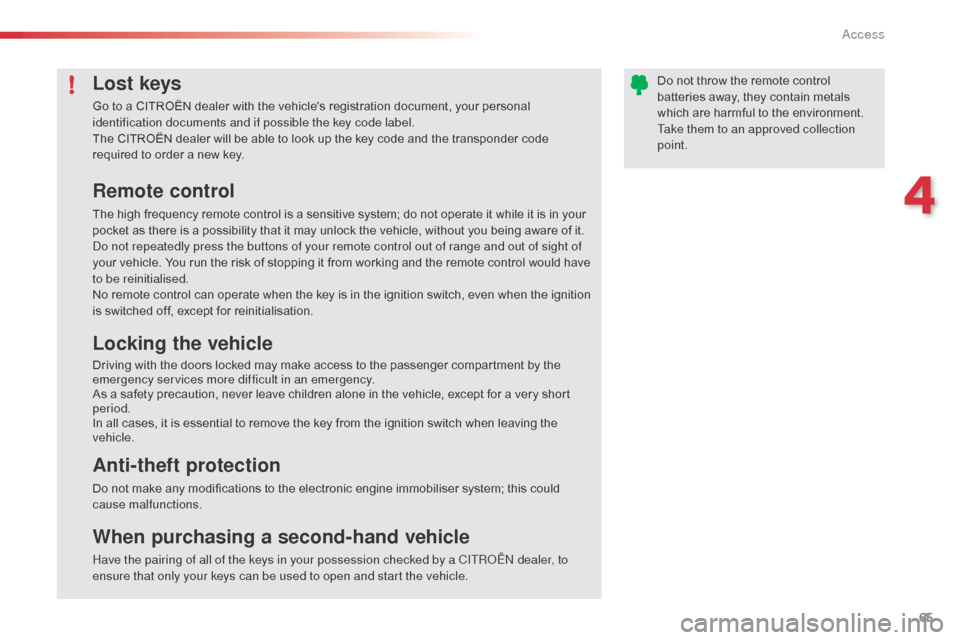
65
Lost keys
Go to a CITROËN dealer with the vehicle's registration document, your personal
identification documents and if possible the key code label.
The CITROËN dealer will be able to look up the key code and the transponder code
required to order a new key.
Remote control
The high frequency remote control is a sensitive system; do not operate it while it is in your
pocket as there is a possibility that it may unlock the vehicle, without you being aware of it.
do n
ot repeatedly press the buttons of your remote control out of range and out of sight of
your vehicle. You run the risk of stopping it from working and the remote control would have
to be reinitialised.
No remote control can operate when the key is in the ignition switch, even when the ignition
is switched off, except for reinitialisation.
Locking the vehicle
Driving with the doors locked may make access to the passenger compartment by the
emergency services more difficult in an emergency.
As a safety precaution, never leave children alone in the vehicle, except for a very short
period.
In all cases, it is essential to remove the key from the ignition switch when leaving the
vehicle.
Anti-theft protection
Do not make any modifications to the electronic engine immobiliser system; this could
cause malfunctions.
When purchasing a second-hand vehicle
Have the pairing of all of the keys in your possession checked by a CITRoËn dealer, to
ensure that only your keys can be used to open and start the vehicle. Do not throw the remote control
batteries away, they contain metals
which are harmful to the environment.
Take them to an approved collection
point.
4
Access
Page 112 of 401
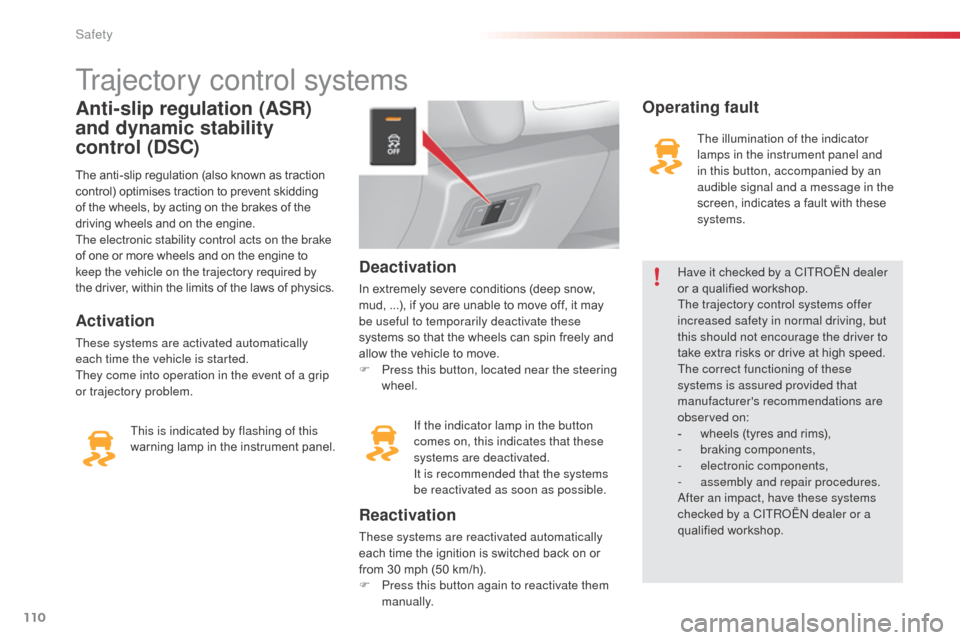
110
Trajectory control systems
Anti-slip regulation (ASR)
and dynamic stability
control (DSC)
The anti-slip regulation (also known as traction
control) optimises traction to prevent skidding
of the wheels, by acting on the brakes of the
driving wheels and on the engine.
The electronic stability control acts on the brake
of one or more wheels and on the engine to
keep the vehicle on the trajectory required by
the driver, within the limits of the laws of physics.
Activation
These systems are activated automatically
each time the vehicle is started.
They come into operation in the event of a grip
or trajectory problem.This is indicated by flashing of this
warning lamp in the instrument panel.
Deactivation
In extremely severe conditions (deep snow,
mud, ...), if you are unable to move off, it may
be useful to temporarily deactivate these
systems so that the wheels can spin freely and
allow the vehicle to move.
F
P
ress this button, located near the steering
wheel.
If the indicator lamp in the button
comes on, this indicates that these
systems are deactivated.
It is recommended that the systems
be reactivated as soon as possible.
Reactivation
These systems are reactivated automatically
each time the ignition is switched back on or
from 30 mph (50 km/h).
F
P
ress this button again to reactivate them
manually.
Operating fault
The illumination of the indicator
lamps in the instrument panel and
in this button, accompanied by an
audible signal and a message in the
screen, indicates a fault with these
systems.
Have it checked by a CITR
oËn
dealer
or a qualified workshop.
The trajectory control systems offer
increased safety in normal driving, but
this should not encourage the driver to
take extra risks or drive at high speed.
The correct functioning of these
systems is assured provided that
manufacturer's recommendations are
observed on:
-
w
heels (tyres and rims),
-
b
raking components,
-
el
ectronic components,
-
a
ssembly and repair procedures.
af
ter an impact, have these systems
checked by a CITR
oËn
dealer or a
qualified workshop.
Safety
Page 128 of 401

126
In exceptional circumstances, the
gearbox may need an automatic
reinitialisation: starting and gear
changing are no longer possible.
Operating fault
With the ignition on, if this warning
lamp comes on and AUTO flashes,
accompanied by an audible signal
and a message in the multifunction
screen, this indicates a gearbox
fault.
Have it checked by a CITR
oËn
dealer or a qualified workshop.
Reinitialisation
(5-speed electronic
gearbox)
AUTO and - - appear in the
instrument panel.
F
Sel
ect position N .
F
P
ress the brake pedal.
F
W
ait for around 30 seconds until N or a
gear appears in the instrument panel.
F
M
ove the gear selector to position A , then
to position N .
F
W
ith your foot still on the brake pedal, start
the engine.
The gearbox is operational again. AUTO
and - - appear in the
instrument panel.
Follow the procedure described above.
Following disconnection of the battery, it is
necessary to reinitialise the gearbox.
F
S
witch on the ignition.
driving